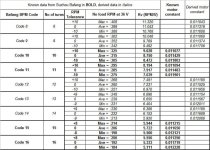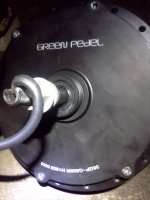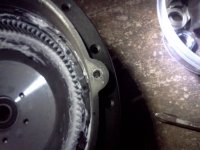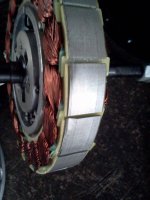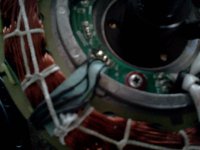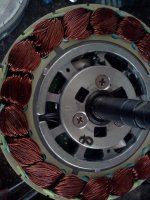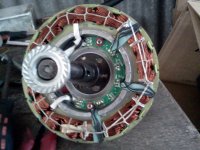The motor arrived promptly, shipped in 4 days from Nanjing to Adelaide, South Australia, it was delivered when the tnt tracking widget said it was still in sydney. To external appearances it looks well made, now lets open it up to check inside.
Dissassembly revealed several small defects from poor care during assembly, notable two of the casing cover screws were stripped from misalignment during insertion and the holes in the side cover were not properly countersunk and had been hand ground out larger to make the screws fit, an easy to fix defect but still a defect.
Internally everything looks good except for three small dents in the stator teeth from rough handling, probably tossed into a bin full of unwound stators after the centre is die cast in to the laminate stack, lams are 0.5mm
One hall wire was poorly positioned and crushed when the windings were pressed as part of the compaction process
The shaft could have been machined better as on one end the threaded section extends within the axel seal where there should be a smooth section for the seal to run on and the other end there is a smooth section but it is 0.3mm too small for the seal lips to actually touch and seal.
the stator is not perfectly concentric in the magnet bowl with the air gap varying around the circumference from extreemly close but not touching to about 0.6mm on the other side, the excentricity stays on one side of the stator so is not bowl wobble.
The magnet bowl looks well made but does not have the lightening slots of the bafang unit only three small 10mm holes in a solid alloy disk that holds the steel magnet backing ring.
IMHO these are all small defects and can be dealt with
the stator has an 8 stamped on it for 8 turn and the phase bundles are substantially thick, much more so than the pissant wires that exit the axel, i took Spinningmagnets suggestion and chopped them of at the end of the axel prior to dissassembly.
On the bright side the rest of the assessment looks good andthere is nothing that would have prevented the motor from running.
It came with well positioned hall sensors and included what appears to be an integral temperature sensor glued to the stator the stator is 17mm wide and the magnets are 18mm wide there is a little flux leakage through the bowl backing but it is small holding a paper clip but not a screwdriver.
There was a small squeek from rotation the magnet bowl that turned out to be an overly long piece of winding packing paper that was scraping on the magnet bowl side plate.
Gears are the white nylon type with unsealed bearings
One side plate had an unsealed bearing and the other had a sealed one, there are standard industrial lip oil seals pressed in to both side plates but they are useless as the shaft land is too small in diameter to touch the seal lips.
The roller clutch works flawlessly and is smooth with little resistance in the freewheel direction and grips in the other like it should
The other supprise is the shaft is keyed to the clutch with 2 keys opposite each other not the 4 milled into the shaft or singly key like other models that have been examined on ES before, greenpedal says they can supply replacement clutches and gears if they are needed so this should not be a problem.
The biggest flaw IMHO is the shaft not having the right diameter polished lands for the oil seals to function as this makes using it as a hub motor with ATF difficult although they could be sleeved for a perfect seal if that was needed.
Will post testing details soon


